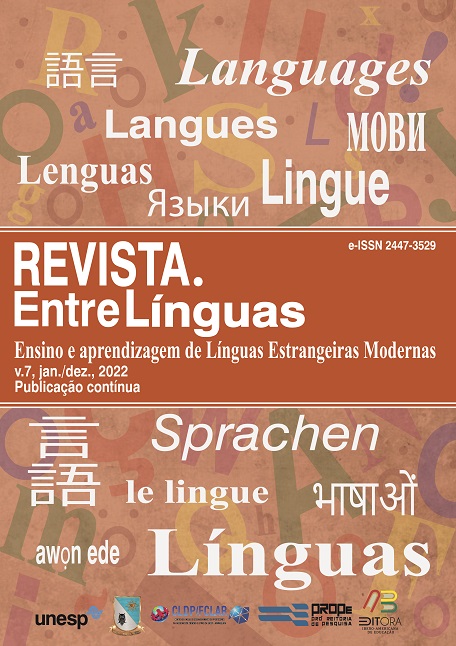Reproduction of intersemiotic modality in the film adaptation of the novel “Harry Potter and the Philosopher's Stone”
DOI:
https://doi.org/10.29051/el.v8i00.17592Keywords:
Translation, Intersemiotic translation, Modality, Film adaptation, Harry PotterAbstract
The article focuses on the formulation of the strategy of reproduction of modal words in intersemiotic translation of the film adaptation of "Harry Potter and the Philosopher's Stone" by J. K. Rowling. This article aims to describe the adaptive strategies carried out during the adaptation of the literary work, which can be expressed in acting, gestures, movements, and shots. Such approach allows to reflect elements as natural phenomena, buildings, movable and immovable objects. The use of adaptive strategies in both productions as well as the author's modality were explored, and the comparison of dialogues was presented. It was established that in literary works, modal words are frequently found in the author's words and in the characters’ reflections, i.e., in those segments that are susceptible to corrosion during intersemiotic translation. Therefore, to maintain the author's intention, translators’ resort to certain adaptive strategies, and the main strategies were identified on the example.
Downloads
References
ALGEO, J. A Comprehensive Grammar of the English Language. By Randolph Quirk, Sidney Greenbaum, Geoffrey Leech, and Jan Svartvik. London: Longman. 1985. x + 1779. Journal of English Linguistics, v. 20, n. 1, p. 122-136, Apr. 1987. DOI: 10.1177/007542428702000108. Available: https://journals.sagepub.com/doi/10.1177/007542428702000108. Access: 2 Apr. 2022.
ANDERSON, S. R. Linguistic expression and its relation to modality. In: ANDERSON, S. R. Current Issues in ASL Phonology. Elsevier, 1993. p. 273-290. ISBN 9780121932701. DOI: 10.1016/B978-0-12-193270-1.50018-2. Available: https://www.sciencedirect.com/science/article/pii/B9780121932701500182?via%3Dihub. Access: 2 Apr. 2022.
BRANCO, S. O.; SANTOS, L. S. O uso de atividades de tradução intersemiótica e interlingual em uma sala de aula de língua inglesa como le. Revista EntreLinguas, Araraquara, v. 3, n. 2, p. 203-226, Dec. 2017. DOI: 10.29051/rel.v3.n2.2017.9229. Available: https://periodicos.fclar.unesp.br/entrelinguas/article/view/9229/6966. Access: 2 Apr. 2022.
CAMERON, D. Language, Gender, and Sexuality: Current Issues and New Directions. Applied Linguistics, v. 26, n. 4, p. 482-502, Dec. 2005. DOI: 10.1093/applin/ami027. Available: https://academic.oup.com/applij/article-abstract/26/4/482/145308?redirectedFrom=fulltext. Access: 2 Apr. 2022 .
HERRING, S.; JOHNSON, D.; DIBENEDETTO, T. Participation in electronic discourse in a “feminist” field. In: COATES, Jennifer; PICHLER, Pia. Language and gender: A reader. 2. ed. Wiley-Blackwell, 2011. p. 171-182 .
HOLUBENKO, N.; DEMETSKAYA, V. Category of Modality Through the Prism of Multipole Approaches in the Modern Translation Theory. Journal of History Culture and Art Research, v. 9, n. 2, p. 303, June 2020. DOI: 10.7596/taksad.v9i2.2500. Available: http://kutaksam.karabuk.edu.tr/index.php/ilk/article/view/2500. Access: 2 Apr. 2022.
JAKOBSON, R. On linguistic aspects of translation. In: On translation. Harvard University Press, 1959. p. 232-239.
KAŹMIERCZAK, M. From Intersemiotic Translation to Intersemiotic Aspects of Translation. Przekładaniec, v. 34-35, p. 7-35, 2018. DOI: 10.4467/16891864epc.18.009.9831. Available: https://www.ejournals.eu/Przekladaniec/English-issues/Special-Issue-Word-and-Image-in-Translation/art/13048/. Access: 2 Apr. 2022.
KEANE, C. How to write a selling screenplay: A step-by-step approach to developing your story and writing your screenplay by one of today's most successful screenwriters and teachers. New York: Broadway Books, 1998. 308 p. ISBN 0767900715.
LIKHODKINA, I. A. (Reflection of literary images in cinema or features of intersemiotic translation. Philological sciences. Questions of theory and practice, v. 3-3, n. 69, p. 128-130, 2017. Available: https://elibrary.ru/item.asp?id=28831784. Access: 2 Apr. 2022.
MONEY, J. Hermaphroditism, gender and precocity in hyperadrenocorticism: Psychologic findings. Bulletin of the Johns Hopkins Hospital, v. 96, n. 6, p. 253-264, 1955 .
NIKONOVA, V.; BOYKO, Y. Gender-specific emotivity of Victorian female prose from a multidimensional perspective. Lege artis. Language yesterday, today, tomorrow, v. 4, n. 1, p. 47-82, 2019 .
NUYTS, Jan. Epistemic modality, language, and conceptualization: A cognitive-pragmatic perspective. John Benjamins Publishing, 2001.
O'BARR, W. M. Linguistic evidence: Language, power, and strategy in the courtroom. Elsevier, 2014 .
ROWLING, J.; KAY, J. Harry Potter and the philosopher's stone. Bloomsbury, 2017.
VOLD, E. T. Epistemic modality markers in research articles: a cross-linguistic and cross-disciplinary study. International Journal of Applied Linguistics, v. 16, n. 1, p. 61-87, Mar. 2006. DOI: 10.1111/j.1473-4192.2006.00106.x. Available: https://onlinelibrary.wiley.com/doi/10.1111/j.1473-4192.2006.00106.x. Access: 2 Apr. 2022.
Published
How to Cite
Issue
Section
License

This work is licensed under a Creative Commons Attribution-NonCommercial-ShareAlike 4.0 International License.
Os manuscritos aceitos e publicados são de propriedade da Revista EntreLínguas. Os artigos publicados e as referências citadas na Revista EntreLínguas são de inteira responsabilidade de seus autores.
Transferência de direitos autorais – autorização para publicação
Caso o artigo submetido seja aprovado para publicação, já fica acordado que o(s) autor(es) autoriza(m) a UNESP a reproduzi-lo e publicá-lo na EntreLínguas, entendendo-se os termos “reprodução” e “publicação” conforme definição respectivamente dos incisos VI e I do artigo 5° da Lei 9610/98. O artigo poderá ser acessado pela rede mundial de computadores (Internet), sendo permitidas, a título gratuito, a consulta e a reprodução de exemplar do artigo para uso próprio de quem a consulta, desde que haja a citação ao texto consultado. Essa autorização de publicação 328 EntreLínguas, Araraquara, v. 1, n .2, p. 323-328, jul./dez. 2015 não tem limitação de tempo, ficando a UNESP responsável pela manutenção da identificação do(s) autor(es) do artigo. Os artigos publicados e as referências citadas na Revista EntreLínguas são de inteira responsabilidade de seus autores.











